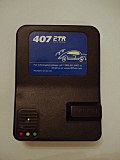Transponder: Difference between revisions
No edit summary |
→See also: fix |
||
| Line 47: | Line 47: | ||
==See also== |
==See also== |
||
* [[Racon]] |
|||
* [[Transceiver]] |
* [[Transceiver]] |
||
* [[Secondary surveillance radar]] ([[Identification friend or foe]]) |
* [[Secondary surveillance radar]] ([[Identification friend or foe]]) |
||
| ⚫ | |||
* [[RFID]] - low-cost transponder tags for asset tracking and telemetry. |
|||
==External links== |
|||
| ⚫ | |||
[[Category:Communication circuits]] |
[[Category:Communication circuits]] |
||
Revision as of 16:09, 6 December 2009

In telecommunication, the term transponder (short-for Transmitter-responder and sometimes abbreviated to XPDR[1], XPNDR[2], TPDR[3] or TP[4]) has the following meanings:
- An automatic device that receives, amplifies, and retransmits a signal on a different frequency (see also broadcast translator).
- An automatic device that transmits a predetermined message in response to a predefined received signal.
- A receiver-transmitter that will generate a reply signal upon proper electronic interrogation.
Satellite/Broadcast communications
A communications satellite’s channels are called transponders, because each is a separate transceiver or repeater. With digital video data compression and multiplexing, several video and audio channels may travel through a single transponder on a single wideband carrier. Original analog video only has one channel per transponder, with subcarriers for audio and automatic transmission identification service ATIS. Non-multiplexed radio stations can also travel in single channel per carrier (SCPC) mode, with multiple carriers (analog or digital) per transponder. This allows each station to transmit directly to the satellite, rather than paying for a whole transponder, or using landlines to send it to an earth station for multiplexing with other stations.
Aviation
Another type of transponder occurs in identification friend or foe systems in military aviation and in air traffic control secondary surveillance radar (beacon radar) systems for general aviation and commercial aviation. Primary radar works best with large all-metal aircraft, but not so well on small, composite aircraft. Its range is also limited by terrain and rain or snow and also detects unwanted objects such as automobiles, hills and trees. Furthermore it cannot always estimate the altitude of an aircraft. Secondary radar overcomes these limitations but it depends on a transponder in the aircraft to respond to interrogations from the ground station to make the plane more visible.
Depending on the type of interrogation, the transponder sends back a transponder code (or "squawk code") (Mode A) or altitude information (Mode C) to help air traffic controllers to identify the aircraft and to maintain separation. Another mode called Mode S (Mode Select) is designed to help avoiding overinterogation of the transponder (having many radars in busy areas) and to allow automatic collision avoidance. Mode S transponders are 'backwards compatible' with Modes A & C. Mode S is mandatory in controlled airspace in many countries. Some countries have also required, or are moving towards requiring, that all aircraft be equipped with Mode S, even in uncontrolled airspace. However in the field of general aviation, there have been objections to these moves, because of the cost, size, limited benefit to the users in uncontrolled airspace, and, in the case of balloons and gliders, the power requirements during long flights.
Marine
Navigational aids often have transponders called RACON designed to make them standout on a ship's radar screen.
Automotive
Many modern automobiles (especially the more expensive models) have keys with transponders hidden inside the plastic head of the key. The owner of the car may not even be aware that the transponder is there because there are no buttons to press. When a key is inserted into the ignition lock cylinder and turned, the car's computer sends a radio signal to the transponder. Unless the transponder replies with a valid code, the computer will not allow the engine to be started. Transponder keys have no battery; they are energized by the radio signal itself.
Road
The E-ZPass system in the eastern United States is one of many systems for paying bridge and road tolls by a RFID transponder in the car. The 407 ETR in Ontario is one of the world's first completely automated toll highways.
Motorsport
Transponders are used in motorsport for lap timing purposes. A cable loop is dug into the race circuit near to the start/finish line. Each car has an active transponder with a unique id code. When the racing car passes the start/finish line the lap time and the racing position is shown on the score board.
Passive and active RFID systems are used in off road events such as Enduro and Hare and Hounds racing, the riders have a transponder on their person, normally on their arm. When they complete a lap they swipe or touch the receiver which is connected to a computer and log their lap time. The Casimo Group Ltd make a system which does this.
NASCAR uses transponders and cable loops placed at numerous points around the track to determine the lineup during a caution period. This system replaced a dangerous race back to the start-finish line.
Underwater
Sonar transponders operate under water and are used to measure distance and form the basis of underwater location marking, position tracking and navigation.
Gated communities
Transponders may also be used by residents to enter their gated communities.
References
 This article incorporates public domain material from Federal Standard 1037C. General Services Administration. Archived from the original on 2022-01-22. (in support of MIL-STD-188).
This article incorporates public domain material from Federal Standard 1037C. General Services Administration. Archived from the original on 2022-01-22. (in support of MIL-STD-188).- Department of Defense Dictionary of Military and Associated Terms
See also
External links
- Transponding with DCC - Transponding in model railroading.
